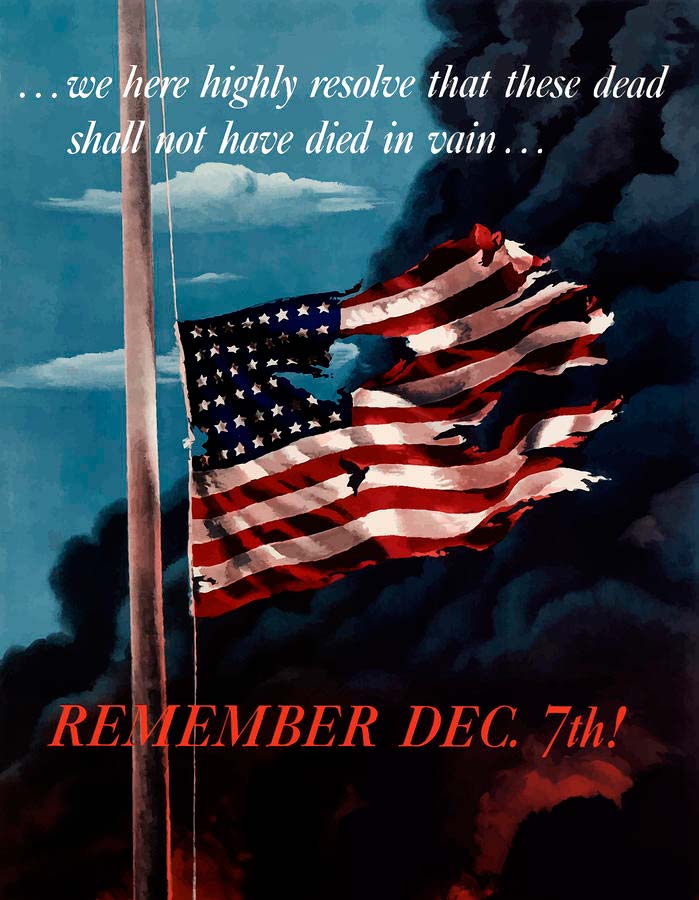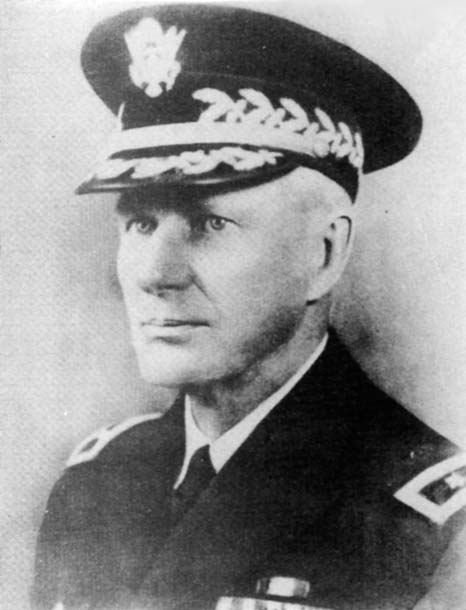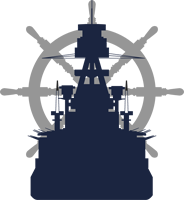The Pearl Harbor Attack: A Brief Commentary
By Heber A. Holbrook

Pearl Harbor Attack Propaganda. Source: FineArtAmerica.com
The single most disastrous event in the history of the American Navy occurred at Pearl Harbor on Sunday December 7, 1941, when the Japanese fleet made a surprise attack on the American Fleet and military shore installations on the island of Oahu. There, in the space of about two hours the pilots of attacking Japanese aircraft sank or damaged seven U.S. battleships, sank or damaged several other ships, destroyed most of the available American aircraft on the ground, some 188 planes, wrecked havoc on Navy, Army, and Marine installations ashore, and killed more than 2000 American servicemen.
Although the American response to the unexpected attack was within minutes, the losses of the attacking Japanese force, only 29 aircraft, 5 midget submarines, and 1 fleet submarine, offers stark reality to the advantage afforded by the element of surprise.
With this commentary is a compilation of the ships present and casualty figures , with source references. The records, compiled and maintained by United States government departments and offices, can all to be found in public libraries or on the Internet.
The United States Pacific Fleet was at Pearl Harbor, Territory of Hawaii, going about the business of shoring up U.S. defenses in response to the threat of an armed confrontation with Japan, during a period when the United States was in discussions with Japan in an attempt to resolve by diplomatic means the disagreements between the two countries, which by mid-November 1941 had reach a crisis.
For a decade the Western world had watched the Japanese nation march into China, to set up the puppet state of Manchuria [Manchuko], devastate Nanking killing more than a hundred thousand innocents in that city, to occupy Shanghai and butcher its citizens at will, to occupy French Indochina [Vietnam], to join an alliance with the Axis powers of Germany and Italy. In 1941 Japan, as any reading of the tea leaves shows, was bent on a conquest of everything on her side of the Pacific Ocean, including Australia and New Zealand.
On the evening of December 6, 1941, in the Navy Yard at Pearl Harbor, long before the .Battle of the Bands. ended at Bloch Recreation Center there in the Navy Yard, where the band of the flagship of the U.S. Pacific Fleet, the battleship Pennsylvania walked off with the honors of being declared the best, the sailors and soldiers and marines from the downtown areas of Honolulu and Waikiki Beach had begun the return to their ships and stations.
By nine o'clock on that Saturday night the civilian buses from the downtown Navy YMCA were making their stops at Fleet Landing next to the Submarine Base.
In town the last bus would load at eleven o'clock; and liberty, for those who had passes, was up at midnight or one o'clock except for officers and chief petty officers and those with special passes.
At Fleet Landing whaleboats loaded with white -uniformed figures chugged out to Battleship Row, to nests of destroyers and cruisers in East and West Loches, and to the ships tied up singly along the way. Just another Saturday night now coming to a close in the Paradise of the Pacific.
The Navy and Army commanders in Hawaii had to maintain their commands at the manpower level alert called for by the National Emergency declared by the President of the United States; that, and there was just no way for Oahu to accommodate ashore overnight many of the 25,000 sailors and 43,000 soldiers and marines who were stationed aboard the ships and military installations jammed on to that little island.

Admiral Husband E. Kimmer, commander-in-chief of the US Pacific Fleet. Source: Gannett-cdn.com

Lieutenant General Walter Short Commanding General, Hawaii Department, U.S. Army Source: Codoh.com
Admiral Husband E. Kimmel, Commander-in- Chief of the United States Pacific Fleet (and who was in fact at that time the Commander-in-Chief of the entire United States Fleet, meaning he was the overall sea commander of every ship and unit of the United States Navy (other that the U.S. Asiatic Fleet, which came directly under the Chief of Naval Operations in Washington), and Lieutenant General Walter Short, the Commander of the Army in Hawaii, had received a .War Warning. message from Washington on November 27 emphasizing the belief that war, when it came, would start by a Japanese attack of the Philippines, or Indochina, or in the British/ Dutch East Indies, and, for Hawaii the immediate worry was the danger of sabotage.
A few days earlier Admiral Kimmel had sent two of his three aircraft carriers, Enterprise and Lexington, speeding for Midway and Wake Islands to deliver aircraft reinforcements to those outlying defense bases leading to the approaches to the Hawaiian Islands; and a third carrier, Saratoga, was on her way to San Diego to pick up additional aircraft actions all coordinated with, if not directed, by Navy headquarters in Washington.
Admiral Kimmel and General Short, and the Navy and War Department in Washington, had good reasons to believe sabotage was Hawaii's immediate worry in this present crisis.
In 1940 the population of Hawaii was about 426,000, and of that number about 156,000 were Japanese, which was by far the largest ethnic group in the Islands [records the Pacific Islands Year Book, R. W. Robinson, editor, Sydney, Australia, 1942].
In the Japanese population about 80% of the school children attended Japanese language schools in addition to the regular public schools. In the Japanese schools they studied the language, customs and traditions of the mother country of their parents and grandparents. These were schools where, if not all, a large number of the teachers owed their allegiance not to the United States but to Japan, in those years when since 1924 there had been no provision for any of them to become U.S. citizens even for those who may have been otherwise inclined. It is difficult, no, impossible, not to imagine that in the course of their studies the students of the Japanese schools in Hawaii were not being indoctrinated in Japan's belief in the deity of Japan's Emperor and in Japan's announced belief in its destiny of creating a " greater East Asia Co-Prosperity Sphere" under Japan's banner.
Upton Close, an American historian, and alarmist of the period [Behind the Face of Japan, 1942] , who seems to have had it about right, backed up by the FBI in Honolulu, records that some 50,000 Japanese in Hawaii worshipped at Shinto shrines, and he noted that Shintoism believed and taught that the Emperor of Japan was the Son of Heaven, who was meant to rule the Earth, and all Japanese were under an edict from Heaven to obey him.
The FBI in Honolulu concluded that the Shinto cult was used as a major instrument through which Japan's militarists could .glorify their policy of aggression.. Robert L. Shivers, the FBI Agent in Hawaii, in testimony before the Roberts Committee, in Pearl Harbor Report, Part 23, laid it all out. The FBI knew of some 234 Japanese Consular Agents in Hawaii, all unregistered and in violation of Federal law, which had never been enforced, appointed by the Consul General of apan in, and who, Shivers said, would .constitute a first-class espionage network.. Scattered throughout the Hawaiian Islands, 99% of the agents were Japanese aliens.
Thus on that December Sunday morning General Short, his aircraft grounded, had his planes lined up in rows, the better to be seen and guarded; and Admiral Kimmel's sea planes at Kaneohe were equally vulnerable to what would be taking place; but Kimmel's aircraft carriers were all at sea as were more than half of his other warships; leaving only his battleships in port as the backbone of the fleet, too slow to keep up with the carriers on their missions that weekend.
The Main Threat to Hawaii, as history and all who held that view would soon learn, was wrong, for unknown to them, and to all of us who were there, a Japanese armada of six aircraft carriers, with battleships, cruisers, destroyers, and submarines, was just over the horizon, and would launch a surprise attack against the U.S. Fleet in Pearl Harbor and the shore installations on the island of Oahu.
The first bombs fell at 0755, and in the devastation which quickly followed more than 2,400 lives were lost in the warships and military installations ashore. .Battleship Row. took the brunt of the attack, with more than a thousand men killed aboard the Arizona, and more than four hundred killed aboard the Oklahoma.
In the aftermath the Navy and the Army commanders were labeled as negligent, were relieved of their commands and retired in disgrace.
In later years as the restricted files of World War II became available for public review it became obvious that Admiral Kimmel and General Short had been made the scapegoats shouldering the blame for the destruction that took place on that Sunday morning, when in reality their Washington superiors had a great deal to do with
Who Was to Blame for Pearl Harbor?
President Harry S. Truman in approving the 1945 Navy Court of Inquiry said:
I have read it very carefully, and I came to the conclusion that the whole thing is the result of the policy which the country itself pursued. The country was not ready for preparedness. Every time the President [Franklin Roosevelt] made an effort to get a preparedness program through Congress, it was stifled. Whenever the President made a statement about the necessity of preparedness he was vilified for doing it. I think the country is as much to blame as any individual in this final situation that developed at Pearl Harbor- as in Pearl Harbor: Why, How, Fleet Salvage and Final Appraisal, by Vice Admiral Homer N. Wallin, USN (Ret). Naval History Division, Washington, D.C. 1968.

Honolulu Star Bulletin 1st EXTRA. Source: Codoh.com
Ships Present at Pear Harbor
A Navy Department Listing
DEPARTMENT OF THE NAVY
NAVAL HISTORICAL CENTER 901 M STREET SE --WASHINGTON NAVY YARD WASHINGTON DC 20374-5060
Ships Present at Pearl Harbor,
0800 7 December 1941
The U.S. Navy ships in the list below are sorted by type and hull number, for example New Orleans (CA-32) is found in hull number order under heavy cruisers. For the purposes of this list, yard craft assigned to the Fourteenth Naval District and other small noncommissioned craft are not included. In addition, Pearl Harbor is defined as the area inside the nets guarding the harbor entrance.
Ships marked with an asterisk (*) were within twelve miles of the island of Oahu but were not actually within Pearl Harbor as defined above. Locations of these ships are indicated. Ships marked with a number symbol (#) were sunk or destroyed during the Pearl Harbor attack. All of these were later raised and rebuilt except for Arizona, Oklahoma, and Utah. Oklahoma was raised but not rebuilt.
Battleships (BB)
- Pennsylvania (BB-38) (in drydock)
- # Arizona (BB-39)
- Nevada (BB-36)
- # Oklahoma (BB-37)
- Tennessee (BB-43)
- # California (BB-44)
- Maryland (BB-46)
- # West Virginia (BB-48)
Heavy Cruisers (CA)
- New Orleans (CA-32)
- San Francisco (CA-38)
Light Cruisers (CL)
- Raleigh (CL-7)
- Detroit (CL-8)
- Phoenix (CL-46)
- Honolulu (CL-48)
As Recorded
- St. Louis (CL-49)
- Helena (CL-50
Destroyers (DD)
- Allen (DD-66)
- Schley (DD-103)
- Chew (DD-106)* Ward (DD-139) (patrolling Channel entrance to Pearl Harbor)
- Dewey (DD-349)
- Farragut (DD-348)
- Hull (DD-350)
- MacDonough (DD-351)
- Worden (DD-352)
- Dale (DD-353)
- Monaghan (DD-354)
- Aylwin (DD-355)
- Selfridge (DD-357)
- Phelps (DD-360)
- Cummings (DD-365)
- Reid (DD-369)
- Case (DD-370)
- Conyngham (DD-371)
- Cassin (DD-372) (in drydock)
- Shaw (DD-373) (in floating drydock)
- Tucker (DD-374)
- Do wnes (DD-375) (in drydock)
- Bagley (DD-386)
- Blue (DD-387)
- Helm (DD-388)
- Mugford (DD-389)
- Ralph Talbot (DD-390)
- Henley (DD-391)
- Patterson (DD-392)
- Jarvis (DD-393)
Submarines (SS)
- Narwhal (SS-167)
- Dolphin (SS-169)
- Cachalot (SS-170)
- Tautog (SS-199)
Minelayer (CM)
- # Oglala (CM-4)
Minesweeper (AM)
- Turkey (AM-13)
- Bobolink (AM-20)
- Rail (AM-26)
- Tern (AM-31)
- Grebe (AM-43)
- Vireo (AM-52)
Coastal Minesweeper (Amc)
- Cockatoo (Amc-8)
- Crossbill (Amc-9)
- Condor (Amc-14)
- Reedbird (Amc-30)
Destroyer Minelayer (DM)
- Gamble (DM-15)
- Ramsay (DM-16)
- Montgomery (DM-17)
- Breese (DM-18)
- Tracy (DM-19)
- Preble (DM-20)
- Sicard (DM-21)
- Pruitt (DM-22)
Destroyer Minesweeper (DMS)
- Zane (DMS-14)
- Wasmuth (DMS-15)
- Trever (DMS-16)
- Perry (DMS-17)
Patrol Gunboat (PG)
- Sacramento (PG-19)
Destroyer Tender (AD)
- Dobbin (AD-3)
- Whitney (AD-4)
Seaplane Tender (AV)
- Curtiss (AV-4)
- Tangier (AV-8)
- Small Seaplane Tender (AVP)
- Avocet (AVP-4)
- Swan (AVP-7) (on marine railwaydock)
Seaplane Tender, Destroyer (AVD)
- Hulbert (AVD-6)
- Thornton (AVD-11)
Ammunition Ship (AE)
- Pyro (AE-1)
Oiler (AO)
- Ramapo (AO-12)
- Neosho (AO-23)
Repair Ship (AR)
- Medusa (AR-1)
- Vestal (AR-4)
- Rigel (AR-11)
Submarine Tender (AS)
- Pelias (AS-14)
Submarine Rescue Ship (ASR)
- Widgeon ASR-1)
Hospital Ship (AH)
- Solace (AH-5)
Cargo Ship (AK)
- *Vega (AK-17) (at Honolulu)
Stores Issue Ship (AKS)
Castor (AKS-1) *Antares (AKS-3) (at Pearl Harbor entrance)Ocean Tug (AT)
- Ontario (AT-13)
- Sunnadin (AT-28)
- *Keosanqua (AT-38) (at Pearl Harbor entrance)
- *Navajo (AT-64) (12 miles outside Pearl Harbor entrance)
Miscellaneous Auxiliary (AG)
- # Utah (AG-16)
- Argonne (AG-31)
- Sumner (AG-32)
